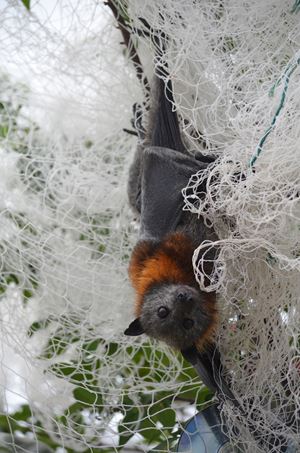
It's time to end their suffering.
Wednesday, May 15, 2019
Netting entanglements can result in constriction wounds, abrasions, fractured bones and even death. Any netting which has holes large enough for your pinky to fit through is a danger for wildlife.
As Flying-foxes forage for food, their toes and wings can get caught in the netting holes. The more they struggle to get free by twisting and turning their bodies, the more entangled they become. Rizzo was one of four bats entangled in a fruit tree in Fairfield earlier this year. Rescuer Michelle described it as one of the most emotionally and physically challenging rescues she has ever attended.
Michelle and fellow WIRES rescuer Jessi worked tirelessly to get the bats down as quickly as possible. It is crucial that the bat is cut free and secured in a shady location as quickly as possible as heat stress can be fatal for bats.
Entanglement rescues are very time sensitive and require a lot of specialised equipment. Bats are usually rehydrated on-site by providing fluids via subcutaneous injection. This method of rapid rehydration dramatically increases their chance of survival and saved Rizzo’s life the day she was rescued.
HELP US TODAY SO WE CAN SAVE MORE ANIMALS LIKE RIZZO
Rizzo was very lucky to escape her ordeal with only minor injuries and dehydration. Many bats do not survive their injuries.
Fortunately, these situations are entirely preventable.
There is wildlife friendly netting available from most major hardware stores. This netting has small holes, less than 5mm wide, which prevents wings and toes being caught. Purchasing only this netting or choosing to leave trees net free is a simple choice which prevents many animals suffering entanglements.
Donate now to help us raise awareness of wildlife friendly netting and continue to rescue the victims of entanglements.
Download or view our factsheet to find out more about wildlife friendly netting.
Recent Posts
WIRES launches its first wildlife rehabilitation centre - Mullyang
WIRES Emergency Response in the wake of ex-tropical cyclone Alfred
International Women’s Day Volunteer Spotlight: Shelley
Tropical Cyclone Alfred – Emergency Wildlife Advice
Interview with WIRES Training and Development
Celebrating Women in Science: The Journey of Holly, Wildlife Conservationist and WIRES Team Member
